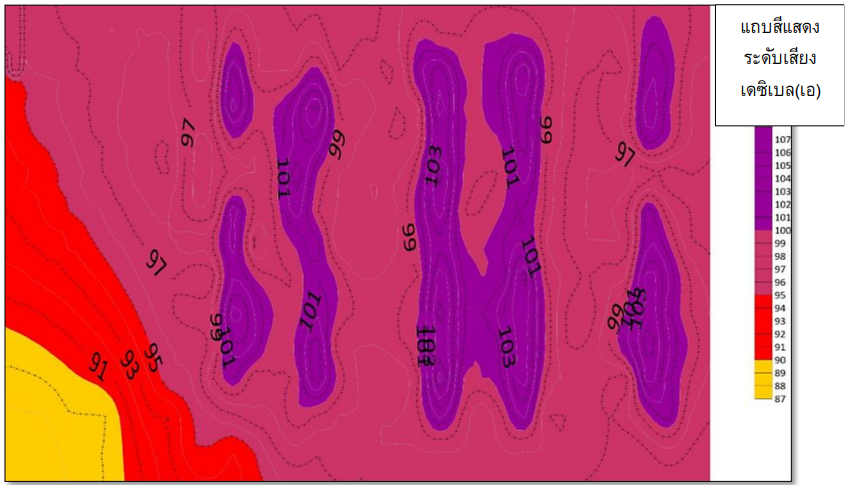The Measurement and Mapping of Noise Levels in a Factory Plastic Sack Production Process in Ratchaburi
Main Article Content
Abstract
This study aimed to evaluate the measurement and noise mapping in the work environment of plastic sack production factory in Ratchaburi. By assessing the noise level in the work environment and to check a noise contour map (Noise Contour Map) and determine the wearing area of personal protective equipment (Personal Protective Equipment) in checking the area working. The area was divided into 11 areas, including 352 measurement points and using a sound level meter, the standard NL-42EX (Class 2) and a sound level meter. Sound analyzer 25 to 141 dB Standard Class 2 Frequency weighting A / C / Z, range 20Hz to 8kHz Standard body IEC 61672 Type 2, ANSI S1.4, JISC1509-1 checking the sound level measurement results to map the sound curve (Noise Contour Map) and while determining and checking the area the checker should wear personal protective equipment (Personal Protective Equipment). The results of the measurement volume found that compared to the standards of the Department of Labor Protection and Welfare's announcement on the standard of noise levels that allow employees to receive averages throughout the period. Last 2018 found that every area in the plastic sack production process had noise that exceeded the standard at 352 points, representing 100%, the average noise level was 98.7 dB(A). Measures must be put in place to prevent and reduce the impact of employee noise while working. In order to prevent hearing deterioration, initially should be required to use personal protective equipment, namely ear plugs (Ear Plug), which is a device that can reduce exposure to loud noise and measures should be taken to preserve hearing in accordance with the law and to reduce employee hearing risk.
Article Details
เนื้อหาและข่อมูลในบทความที่ลงตีพิมพ์ในวารสารวิชาการ เทคโนโลยี พลังงาน และสิ่งแวดล้อม บัณฑิตวิทยาลัย วิทยาลัยเทคโนโลยีสยาม ถือเป็นข้อคิดเห็นและความรับผิดชอบของผู้เขียนบทความโดยตรง ซึ่งกองบรรณาธิการวารสารไม่จำเป็นต้องเห็นด้วย หรือว่าร่วมรับผิดชอบใด ๆ
บทความ ข้อมูล เนื้อหา รูปภาพ ฯลฯ ที่ได้รับการตีพิมพ์ในวารสารวิชาการ เทคโนโลยี พลังงาน และสิ่งแวดล้อม บัณฑิตวิทยาลัย วิทยาลัยเทคโนโลยีสยาม ถือเป็นลิขสิทธิ์ของวารสารวิชาการ เทคโนโลยี พลังงาน และสิ่งแวดล้อม บัณฑิตวิทยาลัย วิทยาลัยเทคโนโลยีสยาม หากบุคคล หรือหน่วยงานใดต้องการนำทั้งหมด หรือส่วนหนึ่งส่วนใดไปเผยแพร่ต่อ หรือเพื่อกระทำการใด ๆ จะต้องได้รับอนุญาต เป็นลายลักษณ์อักษรจากวารสารวิชาการ เทคโนโลยี พลังงาน และสิ่งแวดล้อม บัณฑิตวิทยาลัย วิทยาลัยเทคโนโลยีสยาม เท่านั้น
References
สำนักโรคจากการประกอบอาชีพและสิ่งแวดล้อม. (2563, พฤศจิกายน. 10). รายงานสถานการณ์โรคและภัยสุขภาพ จากการประกอบอาชีพและสิ่งแวดล้อม ปี2559, [ระบบออนไลน์], แหล่งที่มา: http://envocc.ddc.moph.go.th/uploads/situation/01_envocc_situation_59.pdf
อุไรวรรณ หมัดอ่าดัม, สุภาภรณ์ ยิ้มเที่ยง, ทัศณุ เรืองสุวรรณ์, จิตตาภรณ์ มงคลแก่นทราย และ นุจรีย์ แซ่จิว. “การสูญเสียการได้ยินของพนักงานชาวเมียนมาที่สัมผัสเสียงดัง ในโรงงานแปรรูปไม้ยางพารา จังหวัดนครศรีธรรมราช”,วารสารพยาบาลศาสตร์และสุขภาพ, 41(4), 2561, หน้า 23-33.
ประกาศกรมสวัสดิการและคุ้มครองแรงงาน. “หลักเกณฑ์ วิธีการตรวจวัด และการวิเคราะห์สภาวะการทำงานเกี่ยวกับระดับความร้อน แสงสว่าง หรือเสียง รวมทั้งระยะเวลาและประเภทกิจการที่ต้องดำเนินการ พ.ศ.2561” ราชกิจจานุเบกษาเล่ม 135 ตอนพิเศษ 57 ง.
ยุพดี จินดาพงษ์. “การพัฒนาระบบการเฝ้าระวังสุขภาพและสิ่งแวดล้อมในโรงงานปั่นทออุตสาหกรรม เพื่อป้องกันการสูญเสียการได้ยินจากเสียงดัง”, วารสารแพทย์เขต6-7, 27(2-3), 2551, หน้า 979-987.
มัตติกา ยงประเดิม. (2563, ธันวาคม. 18). การวัดระดับเสียงและแผนที่เส้นเสียงในกระบวนการผลิตของโรงงานสิ่งทอจังหวัดขอนแก่น, [ระบบออนไลน์], แหล่งที่มา: http://jes.rtu.ac.th/rtunc2017/pdf/Oral%
วิชาญ บุญค้ำ และ วราภรณ์ ทุมวงษ์. “การตรวจวัดและการจัดทำแผนที่เสียงรบกวนในโรงงานผลิตตู้แช่เย็น จังหวัดกรุงเทพมหานคร”, วารสารวิชาการ เทคโนโลยี พลังงานและสิ่งแวดล้อม บัณฑิตวิทยาลัย วิทยาลัยเทคโนโลยีสยาม, 6(2), (2562), หน้า 21-29
กระทรวงแรงงาน. (2563, ธันวาคม. 11). แนวปฏิบัติตามกฎกระทรวง กำหนดมาตรฐานในการบริหารและการจัดการด้านความปลอดภัย อาชีวอนามัย และสภาพแวดล้อมในการทำงานเกี่ยวกับความร้อน แสงสว่าง และเสียง พ.ศ. 2549, [ระบบออนไลน์], แหล่งที่มา: http://medinfo2.psu.ac.th/commed/occmed/images/TIS18001/tisp4/law%20Physi/imageslaw/practice_hot.pdf
สำนักจัดการคุณภาพอากาศและเสียง. (2563, พฤศจิกายน. 24). คู่มือวัดเสียงรบกวน, [ระบบออนไลน์], แหล่งที่มา: https://www.pcd.go.th/wpcontent/uploads/2020/06/pcdnew-2020-06-05_06-47-44_590694.pdf
ประกาศกรมสวัสดิการและคุ้มครองแรงงาน. “มาตรฐานระดับเสียงที่ยอมให้ลูกจ้างได้รับเฉลี่ยตลอดระยะเวลาการทำงานในแต่ละวัน พ.ศ.2561” ราชกิจจานุเบกษาเล่ม 135 ตอนพิเศษ 19 ง.


